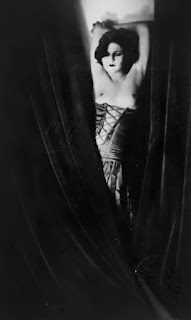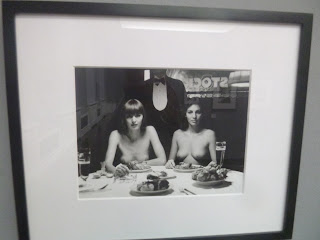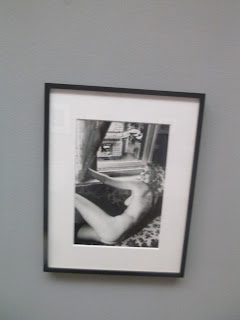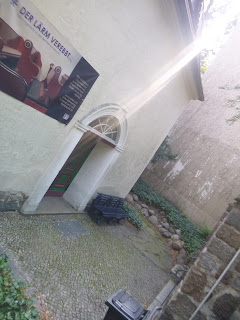Summer in Berlin, Berlin, Christopher Street Day, Strolls through Isherwood’s City, Don’t Be Fooled: Project 2025 is moving ahead. Week Four
Caroline and I went on a pilgrimage through the Tiergarten to the site where Rosa Luxemburg and Karl Liebknecht were killed on January 15 1919, after their short-lived revolution. Met Jana at the Schwarzes Cafe, a funny name for a cafe. And chatted about Jana's high school meetings there. She told us about Martin Kippenberger, the German artist who used to pay his bills at the Paris Cafe down the street with his paintings.
Before coffees, we took in the shows from CO to Berlin, Berlin:
Later that we stopped by Two Song Tuesday at Donau 115, where we ran into my friend Andrew, who I hung out with literally three decades ago at the University of Chicago. We talked about our lives and research and the strange twists from social work and encyclopedia entries to PhD work to becoming academics, the losses and our lives, the reasons we came here. And walked home in the rain.
Andrew and I met again the next afternoon at Cafe Laidek, talking about writers and suicides, and the ways the steps of our lives lung forward and backward, through history, between Berlin and New York.
Later that night, Raoul and I met at mein bar, chatting about Mitterrand and Thatcher and French movies, and caught the drag show at "POPPERS on PRIDE… the legendary Wednesday POPPERS party! With Berlin's hottest drag sensations. An extended POPPERs high celebrating club culture, homoerotism and sexual liberation.`` Twenty years ago there was a sex club there, said one of the performers. Everyone enjoyed the poppers and a taste of the freedom still reverberating through this majestic city, where history creeps through every sunset on the railroad tracks. The tradition continues.
The next day, Federico and I met at the Neue Nationalgalerie, stumbled into Micah and Matt, went to see poetry at Hopscotch Reading Room, chatted with Suddarthra about difference and if it's really accepted in Germany. I said goodnight to Fed and Caroline and was off to House of Lunacy, a late night Midsummer Night's Dream themed party at Renate. The line was down the block when I arrived. But my Puck outfit was enough to get in. Inside, the midsummer vibe turned into a sex party in the back rooms, dancing in the main rooms. I only stayed till about 2:30. Took the bus home with the sleepy party people.... into the night.
We started the weekend at Klub-Elsa, running into friends from New York, dancing into the morning, waking to catch the morning Christopher Isherwood tour through Nollendorfstrasse to 17, in Schöneberg where the luminous writer lived, took notes, learned about freedom, chatted with Auden, met a cabaret singer who would become a lifelong friend, probably saw Anita Berber and Marlene Dietrich perform.
We met in front of the plaque at Nollendorfplatz underground station, a pink triangle for the queer people persecuted and murderred in the Third Reich.
From there, Brendon showed us through Isherwood’s neighborhood, “through the Schöneberg of the late 1920s ..” past “the places he lived, socialised and documented in his Berlin Diaries of 1929 to 1933, the vibrance and edge of the Weimar Era, where genders blurred and films caused riots…”
From 1929 to 1933, Isherwood lived here.
November 1918, the German Kaiser Wilhelm II abdicated. A revolution took place, led by Rosa Luxenberg, as Communists and Nazis fought in the streets, thousands dying in the streets during street fights.
In the midst of this, a new constitution was drafted in Weimar, with 14 new chancellors taking power, amid the instability of the subsequent fifteen years. Inflation doubled and doubled again, riots following.
Isherwood knew Paris was over. Berlin was the place.
There was not an itch that couldn't be legally scratched here; Isherwood was drawn to the city. The debauchery had already pulled Auden into its orbit. Isherwood was next. After all, Berlin meant boys.
"I'm looking from my home..." wrote Isherwood... He was a camera, documenting it all,every cabaret he attended, every hookup, everyone he saw, every homeless man, every storm, everything.
"I'm looking for a home here..."
In 1930, he rented an apartment on 17 Nollendorfstraße.
Brendon walked us down the street, stopping in front of two Stolpersteine (stumbling stones) at 13 14 Nollendorfstraße, where Siegfried Perl lived and was deported on the 15th July 1942, sent to Theresienstadt, Ghetto, passing a year later on the 21st September 1943. Julia and Friena, his neighbors, were deported from the same address. Renate, their neighbor saw them in the morning. They were deported later in the afternoon. She was there eight decades later when the Stolpersteine was laid out on the address where they were deported.
The Mayday Riots of 1929, known as Blutmai (Blood May), were thought to be the end of the Weimar Republic. The Nazis let the Socialists and Communists fight it out. And then said see what they've done.
Isherwood moved onto the block, writing everything he saw from his window.
“A BERLIN DIARY (Autumn 1930) From my window, the deep solemn massive street Cellar- shops where the lamps bum aU day, under the shadow of top-heavy balconied facades, dirty plaster frontages em- bossed with scrollwork and heraldic devices. The whole district is like this: street leading into street of houses like shabby monumental safes crammed with the tarnished valuables and second-hand furniture of a bankmpt middle class.”
At that same apartment, he met his inspiration for Sally Bowles, Jean Ross; the character was half Ross and half the gay men of Berlin. Ross was a “cabaret singer and political writer. Isherwood met her whilst rooming at Fraulein Thurau’s guesthouse at Nollendorfstraße 17....” They would remain friends for the next four decades, going out for lunch in 1975, just a month before Ross died.
Down the street from them, the El Dorado, his favorite bar. The cabarets and gays bars endured regular inspections. They were also are essential income in Berlin. People come here to meet men, get laid, go out. The tolerance is part of the city. But it was disappearing when Isherwood arrived. 1932 witnessed a ban on same sex dancing. With unemployment up and street fighting common, it was simple distraction politics. And soon enough, “the office of public order” came knocking. Under pressure, the El Dorado shut down in 1932. The police came by to ask about the owners. His wife put them off, but they said they’d come back. So they made a decision no one wants to make, filled up their car and drove to Prague, then to the South of France and took a boat to Australia, where their descendents remain, with a trunk full of photos of old patrons of the El Dorado, they are still afraid to reviel for fear of repercussions for the patrons, now almost a hundred years later. In Berlin, the police turned the El Dorado into SA headquarters. People are terrified. Today, it is a Dennis Biobiodiesel. They still have a guestbook for the El Dorado with names, such as Cecil B Demille and Marlene Dietrich.
And sure enough Anita Berber performed there. Two songs, a joke, and she was out of there, off to another club, dressed in nothing but a fur coat with a coke vial about her neck, a monkey on her shoulder, ever performing, transgressing, finally pissing off the wrong customer, whose table she peed on, smashing a champagne bottle. This was a little much, even for Berlin standards. She went on the road to pay her bills playing other venues,when the Berlin clubs cut her off, becoming ever more sick, each night on the road, dying in Berlin in 1928. Her parts remain in a park named after her in Neukölln. A gaggle of Berlin drag queens were the only ones at her burial. Otto Dix painted a portrait of her in red, life size.
Isherwood watched his favorite clubs shut down and books burned.
The summer of 1932 was the hottest on record. The winter was equally extreme. Stephen Spender, the English poet and friend of Auden, wrote about the poverty he saw in Berlin, the snow, the cold, wind howling, the destitute diseased and twisted, the poor sleeping in the train stations to escape the elements. Of that Winter, Isherwood wrote:
“Tonight, for the first time this winter, it is very cold. The dead cold grips the town in utter silence, like the silence of intense midday summer heat. In the cold the town seems actually to contract, to dwindle to a small black dot, scarcely larger than hundreds of other dots, isolated and hard to find, on the enormous European map. Outside, in the night, beyond the last new-built blocks of concrete flats, where the streets end in frozen allotment gardens, are the Prussian plains. You can feel them all around you, tonight, creeping in upon the city, like an immense waste of unhomely ocean - sprinkled with leafless corpses and ice-lakes and tiny villages which are remembered only as the outlandish names of battlefields in half-forgotten wars. Berlin is a skeleton which aches in the cold: it is my own skeleton aching. I feel in my bones the sharp ache of the frost in the girders of the overhead railway, in the ironwork of balconies, in bridges, tramlines, lamp-standards, latrines. The iron throbs and shrinks, the stone and the bricks ache duly, the plaster is numb.”
Brendon kept walking us, past the K6, a bar with a view of the prostitutes taking their dates off to the Sally Bowles bar down the street, past the Metropol, where Marlene Dietrich, used to kvell at the stars. Back to the train station at Nollendorfplatz, showing us pictures of the graves by the station during the second world war.
"Shame on you" Isherood whispered, watching the book burnings, books going up in flames. Mass unemployment, violence in the streets and the authorities turned to the cabarets. They had to go. Distraction politics works. Our guide mentioned that earlier in the week, Trump told supporters to "vote just this time... then in four years you won't have to vote again. It'll be fixed." Chilling.
With history swirling through our heads, we stopped for lunch at Cafe Berio, a beloved gay restaurant about to close. Many nursing hang-overs or already drinking, we prepared for the parade to make its way toward us.
The History of Gay Pride in Berlin
And made our way through the crowds celebrating as only Berlinners seem to know, as well as the alternative parade through Kreutzberg, the 2024 motto, only strong together, for democracy and diversity. It's all about sexual freedom, human freedom, from a city that has lost it all, and slowly had to rebuild it. Even after the war, homosexuality was criminalized in the East and West, the policy only changing after the repeal of article 175 in 1989 and 1990 here. The policy predated the Nazis. But they made it harsher in 1935. In the US in New York, activists were busy organizing to stop project 2025 which mimics much of article 175 and old morality codes (see press release below).
Isherwood visited Berlin again in 1952:
“It is strange enough to see a vast city shattered and dead. It is far stranger to see one that is briskly and teemingly inhabited, amidst its ruins. Berlin seemed convinced that it was alive; and, after a few hours there, you began to agree that it certainly was. The street where I used to live is behind the Nollendorfplatz, about ten minutes' walk from the hotel where I was staying. I knew that my old landlady, “Frl. Schroeder,” was still there; we had been corresponding, but I hadn't told her that I was coming to Berlin for fear of a last-minute disappointment. Even before the war, this was a decayed and forbidding district; but when I saw it again I was really awestruck. The fronts of the buildings were pitted with shrapnel and eaten by rot and weather, so that they had that curiously blurred, sightless look you see on the face of the Sphinx…”
Sunday, spent all Sunday at the flomarkets and cafes, outside in a biergarten, back to a cafe, on the Admiralbrucke, out into the street for a nap as a man played Rocky Top. And Fed invited us up for a pizza and a view of the sunset. Looked at Alexanderplatz in the distance, the magic light enveloping us. That night, I had a dream about looking for an obituary for a friend, printed in an old journal, lost, in an old book attack, or was it by the beach? I needed that story for the speech I was about to give, but it seemed lost, the waves crashing on the beach, the dreaming reminding me, leaving me with a question.
Later that Monday afternoon, the teenager arrived; the college kid joined us and for a second, a meal, we were all together again.
They looked about Berlin and it looked strange. A halloumi sandwich and a stroll calmed the nerves.
Before dinner, we found ourselves in the park reading Simone de Beauvoir’s lost novella, Inseparable, her story about her best friend Zaza, her muse and inspiration. “'Life without her would be death' The lost novel from the author of The Second Sex … The compulsive story of two friends growing up and falling apart….From the moment Sylvie and Andrée meet in their Parisian day school, they see in each other an accomplice with whom to confront the mysteries of girlhood. For the next ten years, the two are the closest of friends and confidantes as they explore life in a post-World War One France, and as Andrée becomes increasingly reckless and rebellious, edging closer to peril. Sylvie, insightful and observant, sees a France of clashing ideals and religious hypocrisy—and at an early age is determined to form her own opinions. Andrée, a tempestuous dreamer, is inclined to melodrama and romance. Despite their different natures they rely on each other to safeguard their secrets while entering adulthood in a world that did not pay much attention to the wills and desires of young women. Deemed too intimate to publish during Simone de Beauvoir’s life, Inseparable offers fresh insight into the groundbreaking feminist’s own coming-of-age; her transformative, tragic friendship with her childhood friend Zaza Lacoin; and how her youthful relationships shaped her philosophy. ”
“I’m already more interested in them than I am of the characters in Love in the Time of Cholera,” said B, after listening for 15 minutes.
After dinner at Cafe Paris, they were off to Koti, myself back to Sandman for blues, and Caroline back home for sleep.
More dreams, I watched a bird on the roof across from us, during morning yoga.
Some days I wake up and everywhere I go is a cemetery, at the coffee shop, down the street, behind the graffiti advising not to be weary of the ghosts. Walking today, I thought I'd try to find the grave of one of my heros here. Found the park named after her last stop just down the street, behind yet another Swatch of cemeteries here... "The Anita Berber Park is located in the Berlin district of Neukölln, west of Hermannstrasse in the former flight path of Tempelhof Airport . It was named after the German dancer, actress and self-promoter Anita Berber in 2017 ."
In the meantime, the White Dudes for Harris are organizing.
Says Cleve Jones:
“In 1964, when I was ten years old, President Lyndon Johnson defeated Barry Goldwater to win a full term after assuming the Presidency following the assassination of JFK. My family was politically active and I still remember the campaign vividly. So I've been paying attention to election campaigns for over 60 years.
I've never seen anything like what we have witnessed in the past week. I can't compare it to anything. It is extraordinary.
As an organizer, I am astonished by the depth and breadth and sheer energy of the Harris campaign rollout. As an American, I am grateful beyond words for the hope that has been unleashed in my heart and in the hearts of tens of millions of Americans who believe in democracy and justice.
We live in an historic moment. Take it in. Breathe. Rejoice. Get to work.”
The right wing certainly are.
Stay vigilant and informed.
Media Release: July 31, 2024
Inquiries: stopthecoup2025@gmail.com
Don’t Be Fooled: Project 2025 is moving ahead
Media attention is needed to the remaining agenda – and new battlefront.
Today the nonpartisan campaign to stop Project 2025 issued a warning in response to news that Paul Dans, a key architect and director of the conservative movement political policy blueprint, Project 2025, was stepping down, while the Heritage Foundation would wrap up the project’s policy work. “The American public and media must not be fooled by this attempt to push Project 2025 below the news radar,” said Anne-christine d’Adesky, a journalist and founder of Stop The Coup 2025 campaign, formed last fall to educate the public about Project’s 2025’s agenda. “Even very conservative Americans see Project 2025 as very dangerous when they learn about it. But the project is moving ahead.”
What’s gotten less attention are Pillars 2,3 and 4 of Project 2025, she warned; the 877-page blueprint is only Pillar 1. Already, over 11,000 conservative candidates of a planned 20,000 administrative database pool have applied to join a future Christian-led government. That’s Pillar 2. They are taking an online training course to implement Project 2025’s radical policy proposals – Pillar 3. That part is public knowledge. What’s not made public is Pillar 4: their “180-day Playbook” of instructions for recruits to revise the rules in all 30 departments of government starting on “Day One” – January 20, 2025. The Heritage Foundation has reportedly already readied 150 Executive Orders for “Day One” signing, according to legal sources who reportedly met with The Heritage Foundation to discuss Project 2025.
Yesterday, the Trump campaign issued a public statement about Dans’ step-down, repeating that Trump has had nothing to do with Project 2025. That is false: 81% of its blueprint was written or edited by his close aides, former officials, and 2016 transition aides, and an audio clip even exists of Roberts discussing Trump’s support of Project 2025. “Reports of Project 2025’s demise would be greatly welcomed,” Trump’s campaign stated.
The opposite is needed. We need greater focus on The Heritage Foundation’s activities and the remaining Project 2025 agenda, including an alarming Transition Integrity Project (TIP) report on “election integrity” released on July 10th, with two partners. It presents an “academic exercise” of scenarios that discuss how conservatives might secure victory and a transition to power. “Under the guise of concern about free elections, conservative leaders are preparing to assure their side wins, and go so far as to accuse progressives of gaming the November elections,” warned d’Adesky. “It’s a remarkable gaslighting document, and a compliment to Project 2025’s blueprint. We need to prevent schemes to subvert our democracy.”
Stop The Coup 2025 just released a Toolkit for Community Organizers to support discussion of Project 2025 and plans an October 5 rally with allies in Washington, DC. “We need everyone focused on safeguarding our freedoms.” Stated d’Adesky: “We need to elevate the public awareness and conversation. We need more media focus, not less. All eyes on the Heritage Foundation and its allies and Project 2025.”















































































































































































































































